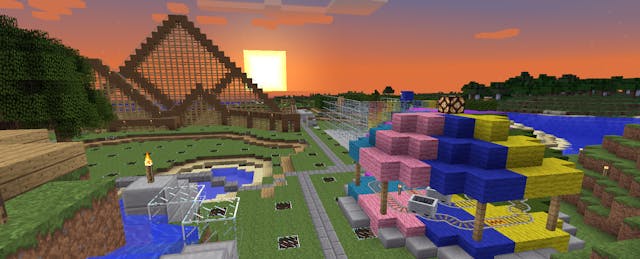In the wake of announcements that Microsoft will be acquiring the Swedish game developer Mojang, otherwise known as the maker of the phenomenon Minecraft, for a rumored $2.5 billion (otherwise known as a casual weekend for Mark Zuckerberg), I have a question to pose to the greater venture and education communities:
What counts as edtech?
I should add a quick preface here, in case you are unfamiliar with this Minecraft of which I speak (unlikely, given that it has sold over 50 million copies and is one of the highest grossing video games of all time). As described on its website:
“Minecraft is a game about breaking and placing blocks. At first, people built structures to protect against nocturnal monsters, but as the game grew players worked together to create wonderful, imaginative things.
It can also be about adventuring with friends or watching the sun rise over a blocky ocean. It’s pretty. Brave players battle terrible things in The Nether, which is more scary than pretty. You can also visit a land of mushrooms if it sounds more like your cup of tea.”
In other words, Minecraft is what is known as a “sandbox” game, an open space where a player can roam through a virtual world untethered, interact with fellow users, and construct and destruct as they see fit. At its core, Minecraft is whatever you want it to be. Check out a brief trailer here.
It is hard to debate the merits of Minecraft as an educational product/platform/community. First and foremost, Minecraft has certainly proven its chops as a tool for engagement, and much of this is due to its simplicity and open-endedness. In the age of HD, 3D and Oculus Rift, Minecraft looks surprisingly similar in visual quality to the computer games I played growing up with my Macintosh Peforma 630. Unlike much of its gaming brethren, Minecraft is not so much about entertainment as it is about creation. It is not limited by a narrative or a direction: it is precisely whatever you want you use it for, though ultimately centered on architectural design.
Many blogs out there have repeatedly dubbed the platform an excellent hub for learning experiences, pointing to a range of applicable use cases across curriculums from Math and Geography to Engineering and General Teamwork. Various databases and Wikis exist solely to recount methods for implementing Minecraft-centric lesson plans into the classroom experience. MinecraftEDU sells licenses direct to institutions that are customized for school implementation, “made by teachers for teachers, fine-tuned for the classroom.” Academic papers have been scripted weighing the merits of the game as a teaching and learning tool.
I suppose one standard for what constitutes “edtech” would be what the folks at EdSurge have to say. They are now publishing and selling monthly reports dubbed “Ka’Ching Insights” that are tracking the funding activity across the edtech landscape, so if this sale appears in the September edition, that is one barometer of note.
But the greater point here is that technology in general (and particularly so with Minecraft) is an enabler of creation and idea expansion--and aren’t these truly the goals and outcome of the learning process? Social media, collaboration tools, even many of the iPad games my 10-year old goddaughter won’t stop playing at the dinner table, are inherently driven by trial, error, and a greater consciousness we often refer to as “Research.” It is impossible to separate these tools from the ultimate and never-ending learning process.
As venture investors in a relatively niche space (though growing in perceived value), we at Rethink Education are always looking for good outcomes and exits as validators of our theses. Exits that prove a great success for entrepreneurs and investors are likely to entice new talent and new dollars to pursue similar activities. My boss Matt Greenfield loves to make reference to the myriad fashion-related tech startups currently bombarding the venture industry and pages of TechCrunch as an example of the herd mentality in venture capital and the over-investment in a segment that provides relatively little differentiation and/or social good. (How many ways can I go about procuring a nice pair of briefs anyway?)
But this flood of investment to a particular segment only exists because previous startups have proven successful outcomes. If we truly want to create an ecosystem of top tier technical and entrepreneurial talent focused on big ideas in education, we need to justify the potential outcomes in the free market of such tools and platforms.
Our own fund was launched essentially on the back of two specific exits we had participated in as angels--the sales of Wireless Generation to NewsCorp and Schoolnet to Pearson--as well as what we perceived to be a gap in the Series A / Series B funding for edtech startups. The momentum of those acquisitions propelled us to receive significant investment and support from leading foundations despite our collective inexperience in running a concentrated venture fund, and neither of those outcomes was particularly close to a $2.5 billion valuation.
So I’m making it official right here: Minecraft is an edtech exit! (Hey VCs, come join the party!)


